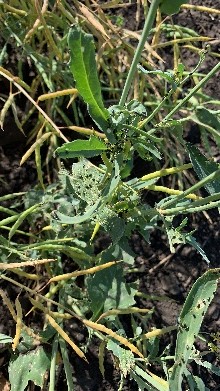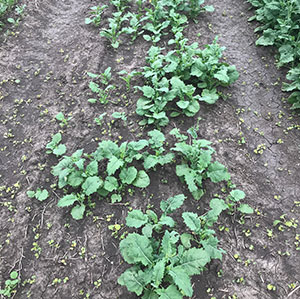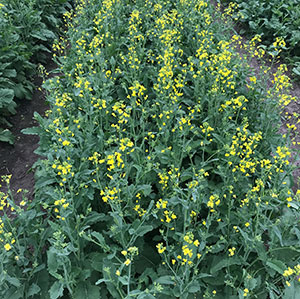Flea beetle management in canola
May 25, 2021
Flea
beetles are the scourge of any canola grower. They attack when canola plants
are at their most vulnerable in the first few weeks after emergence – a time
when you’re also likely to be busy seeding other fields, so getting back to
spray them can be a challenge.
It’s
why seed treatments have become such an important tool when it comes to
limiting flea beetle damage so the canola crop can get past this early stage
and form a strong stand.
But
flea beetle species and range are shifting. It used to be that striped flea
beetles were pretty much a northern problem, while farmers in southern regions
did battle mainly with crucifers. Today, these growers have noticed that the
striped variety are, or nearly are, the dominant species in the south, having
expanded their range enormously in the last few years. Also, flea beetle
populations seem to be higher overall these days.
Does
this shift in species and range mean flea beetle management tactics need to
change? Well, not entirely. But canola growers need to understand what this
shift means to when and how they scout for damage, as well as the seed
treatment product choices that are available to them.
A quick primer
Flea
beetles are an introduced pest, arriving here from Eurasia decades ago. While
most canola growers are eminently familiar with them, a quick refresher on flea
beetle lifecycle and biology can’t hurt.
Adult
flea beetles overwinter at field edges in leaf litter, shelterbelts and
hedgerows. They start to emerge in April, when temperatures get to around 14 to
15 degrees Celsius for a sustained period. Striped flea beetles emerge earlier
than crucifers – from one to four weeks earlier1, which is important
for scouting.
Emerged
adults head straight for any cruciferous plant – canola, volunteer canola,
mustard, flixweed, stinkweed – you name it, they’ll eat it. They tend to start
feeding at field edges and move in from there. Below 14 Celsius, they walk and
hop to plants, above that temperature its warm enough for them to fly and move
further into a field. The warmer it gets, the faster they move and feed.
Egg
laying starts around late May when females deposit them in the soil near the
roots of canola and other host plants. About two weeks later, the eggs hatch
and the larvae feed on nearby plant roots and root hairs.
Around
mid- to late-July, after pupation, the new generation of adult flea beetles
emerge and start to feed on canola plants, going after leaves, stems and pods. It’s
not uncommon to see them mass on a single plant but unlikely to cause any
economic yield damage at this stage (Figure 1).

Figure
1. Aggregation of summer generation of adult crucifer flea beetles feeding on
canola pods.
What gets eaten and when
The
spring-emerging adults cause the most economic damage since they start eating
when the crop is most defenseless. Shot-holes and divots in cotyledons and the
first true leaves are evidence of flea beetle feeding (Figure 2). When pressure
is extreme, flea beetles can even eat a plant’s growing point, resulting in
outright plant death.

Figure
2. Flea beetle adult injury to canola cotyledons.
Research
out of Manitoba indicates larval root feeding can reduce canola yields by about
five percent, while late summer feeding during pod development can lead to
lower seed yield and higher chlorophyll content.2 It’s rare,
however, for late summer feeding to result in measurable economic loss because
by the time the crop reaches the 5.1 to 5.2 (flowering) stage, plants are
pretty much resistant to damage.
Build a multi-layered management plan
There
are two ways to approach flea beetle management, preventative and responsive,
and a good plan includes both.
Preventative tactics
Preventative
management tactics include seed treatments as well as cultural choices, such as
early planting, increasing seeding rates and watching planting depth. It should
be noted that the ultimate goal of all preventative management strategies is to
ensure strong, even emergence and stand establishment – the faster your canola
gets up and past the first two true leaf stage, the less damage flea beetles can
inflict.
Seed treatments. Most canola seed comes pre-treated with, at minimum, a fungicide
package to protect seeds, roots and shoots from seed- and soil-borne diseases.
Adding an insecticidal component to your seed treatment package is a smart
decision, particularly since the earlier emergence of striped flea beetles may
not give you the time to spray.
New
for the 2021 season and beyond, growers can opt for BUTEO™ start, a
new insecticidal canola seed treatment from Bayer. This is the only Group 4D
insecticide (flupyradifurone) in the seed treatment category and one of its
many strengths is that it is taken up very quickly by emerging canola plants,
even in cooler, drier conditions, providing the earliest possible protection.

Fungicide only

Prosper® EverGol®

Prosper® EverGol® +
BUTEO start
Source: Bayer Field Solutions Trials (photos taken July 8, 2019, Rosthern, SK). Treated seeds were seeded the same day.
Seed treatments are the best line of defence against flea beetles because they start to protect young seedlings as they emerge from the ground. Flea beetles have to take a bite of a treated seedling to ingest the insecticide, so plants will always show a little bit of damage but, more often than not, a seed treatment will prevent a spray op and get the crop safely established.
Cultural decisions. Here’s another quick refresher, this time on seeding practices that
encourage strong stand establishment.
- Seedbed preparation. Seedbeds should be level, uniform, well packed and at least five degrees Celsius or more. Direct seeding into standing stubble can create a warm microclimate, plus flea beetles prefer to be in more exposed areas.
- Seed early. You want to hit a sweet spot where the growing conditions are warm enough to not stall or delay plant emergence, which makes seedlings extra vulnerable to flea beetle attack, but early enough that the crop won’t be flowering in the hottest months of summer.
- Boost seeding rate. Bumping your rate up a bit can help lessen the impacts of both natural seed mortality and flea beetle feeding.
- Depth and spacing. Seed no more than an inch deep to ensure rapid emergence. Also, while it’s not clear why this happens, information from Manitoba indicates that wider row spacing of 20 or 30 centimetres can result in less flea beetle damage per plant.2
Responsive
tactics
Responsive
management tactics are basically scouting and spraying, if necessary.
Scouting. Always, always scout. If flea beetle populations are unusually high,
or if spring snow or frost have delayed emergence, even the best seed treatment
may not be enough to protect plants, so you need to get in there during the
first two to three weeks after emergence and see what’s going on.
You
can use sticky traps to detect the presence of flea beetles and maybe even get
a sense of their abundance, but to make a spray decision, you have to look at
the plants themselves.
Sample
representative areas in the field – feeding is usually worse on the field
edges, so be sure to walk well into the field and check out plants there, too.
Estimate the amount of feeding damage on several plants in each area you scout
and average out your results across the field.
Scout every day! Growing conditions have a big impact on flea beetle feeding behaviour,
so you need to be in the field every day to monitor what’s happening.
In
warm, dry weather, flea beetle feeding damage can very quickly go from fairly
mild to beyond economic thresholds in as little as a couple or three days. When
it’s cool and wet, flea beetles slow down, often moving to the underside of
leaves to feed there.
And
include checks for stem damage as you scout. If flea beetles manage to chew
through a stem, the plant will die. It could very well be that leaf damage is
below the economic action threshold, but stem feeding is killing the crop.
When to spray. The economic threshold for spraying is 25 percent or greater feeding
damage on cotyledons – spray immediately. If you calculate less than 25 percent
damage to cotyledons, the crop will likely recover. If you’re still unsure, you
can use this checklist prepared by the Canola Council of Canada to help make your spray decision.
Talk
to your Bayer representative about foliar insecticides registered for flea
beetle control – we are always here to help!
Footnotes:
1 Canola Council of Canada. Canola Encyclopedia.
https://www.canolacouncil.org/canola-encyclopedia/insects/flea-beetles/
2 Gavloski, John. 2020. Flea beetles on canola and mustard.
Manitoba Agriculture and Resource Development. https://www.gov.mb.ca/agriculture/crops/insects/flea-beetles-canola-mustard.html
ALWAYS READ AND FOLLOW PESTICIDE LABEL DIRECTIONS. EverGol® and Prosper® are trademarks of the Bayer Group. Bayer CropScience Inc. is a member of CropLife Canada. ©2021 Bayer Group. All rights reserved.